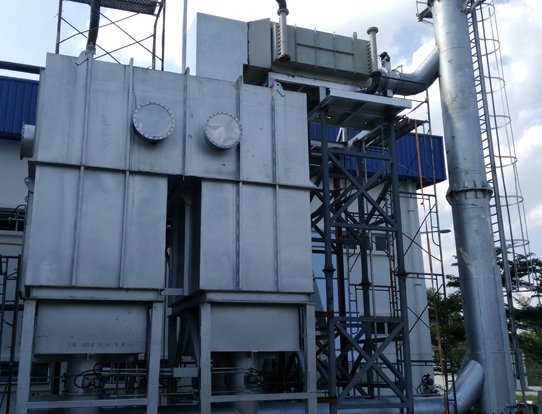1、 Concept of biological treatment of organic waste gas
Biological purification of organic waste gas is developed on the basis of mature selection of microorganisms to treat waste water. Biological purification is essentially an oxidation and decomposition process: active microorganisms attached to porous and wet media take organic components in waste gas as their life activity power or nutrition, and transform them into simple inorganic substances (CO2, H20) or cellular components.
2、 Characteristics of biological treatment of organic waste gas
1. Wide range of application
Volatile organic compounds (VOCs) and other toxic or odorous gases, such as NH3 and H2S.
Hazardous pollutants in chemical, pharmaceutical, electroplating, paint spraying, printing and other industries, as well as odor in wastewater treatment plants, composting plants and waste landfill plants.
2. High removal efficiency
Generally, the removal efficiency of air pollutants exceeds 90%.
3. Low energy consumption
The biological response is carried out under normal temperature and pressure, and the energy comes from the energy generated by microorganisms using VOCs.

3、 Biological treatment principle of organic waste gas
1. Biofiltration
Biofiltration is a biological treatment skill that has been studied and applied for a long time. It is used to treat malodorous gases such as hydrogen sulfide. Now its application scope is extended to volatile organic gases that are easy to be biodegradable. In the purification process, the organic waste gas enters the biological filtration equipment after pretreatment. The filler in the equipment is an adsorptive filter material, which is mainly composed of sawdust, compost, soil and activated carbon with large surface area and porosity. There are abundant microorganisms attached to the packing. Through their innovation activities, various organic waste gases will be decomposed into CO2, H2O, NO3 - and SO4 -, so as to get the intention of effective purification. The biological filtration method has only one reverberator, the liquid phase and biological phase are inactive, the gas-liquid touch area is large, the applied filter has less investment and low operating cost, and the volatile substances such as benzene series, aldehydes and ketones have good removal effect.
Strengths:
Less equipment, simple operation, low investment and operation cost, and high VOCs removal efficiency.
Disadvantages:
The reaction conditions are difficult to control. When the floor area is large and the substrate concentration is high, the biomass increases quickly and easily blocks the filter media, affecting the mass transfer.
2. Biological absorption method
It consists of waste gas absorption and microbial oxidation reaction. The organic waste gas enters from the lower part of the reverberator first, and touches the water phase in the packing layer in the process of upward movement to complete the process of mass transfer; Water carries the dissolved waste gas into the bioreactor, where a large number of microorganisms grow in the suspension, and their metabolic activities are used to remove pollutants. The response conditions are easy to control, but additional nutrients are needed, and there are many equipment and high investment. The bioreactor needs to add aeration equipment, and control temperature and pH conditions to ensure a good state of microbial operation.
Strengths:
There are few equipment, pressure drop, filler is not easy to block, PH is easy to regulate, and it is suitable for treating pollutants with acidic metabolic products.
Disadvantages:
The filler has small specific surface area, high operation cost, and is not suitable for treating compounds with poor water solubility.
3. Biological trickling filtration
Biological trickling filtration is a combination of biological absorption and biological filtration. The absorption and degradation of pollutants occur simultaneously in one reverberator. The filler in the container is generally gravel, ceramics, polypropylene beads, granular activated carbon and other materials with a larger surface area, which acts as a carrier for microbial growth. Spray the nutrient solution to the surface of the packing in advance, flow out of the tower bottom and recycle. Waste gas enters from the bottom of the reverberator and flows through the filler. The biofilm of microorganisms on the filler can act as a biological filter to oxidize substances in the gas phase and liquid phase. The bio trickling filtration method can remove the metabolic products of microorganisms by changing the reflux liquid, and has great buffering ability. It is particularly suitable for substances that produce acidic metabolic products after degradation, such as halogenated hydrocarbons and organic substances containing S and N.
4、 Biological trickling filtration of organic waste gas
1. System quick start skill
The biological trickling filtration system needs to go through the process of strain domestication, inoculation, film hanging, etc., and generally needs more than 45 days to deal with methyl tert butyl ether and other extremely difficult to degrade substances. In order to improve the specialized bacteria with the ability of efficient degradation of pollutants, it is necessary to select the source of the bacteria according to the nature of the pollutants in the policy. For the easily degradable waste gas, alkanes, olefins, alcohols and organic substances, or the odorizing waste gas with complex treatment components, there are sulfides. In urban sewage treatment plants, inoculation strains are generally selected, which can adapt to pollutants and remove pollutants efficiently in a relatively short time. Because activated sludge contains a wide range of bacteria that can degrade a variety of organic compounds, it is an ambitious domesticated source of bacteria for biotrickling filters to purify easily degradable organic waste gases. As for the refractory organic waste gas, it is necessary to select the domesticated strain with special degradation ability or the strain obtained from the pure culture environment according to the specific nature of the pollutants, which can shorten the starting time of the system and improve the decontamination ability of the system.
5、 Comparison of three microbial treatment methods for organic waste gas
Biological scrubbing method: treat waste gas with small purified gas volume, high concentration, easy solubility and low biological metabolism rate;
Biological filter: waste gas with large gas volume and low concentration;
Biological trickling filter: waste gas with high load and acid substances after pollutant degradation.
6、 Widely used microbial waste gas treatment skills
Biological treatment equipment for organic waste gas mainly includes biological scrubber, biological filter and biological trickling filter, among which biological trickling filter is widely used.




